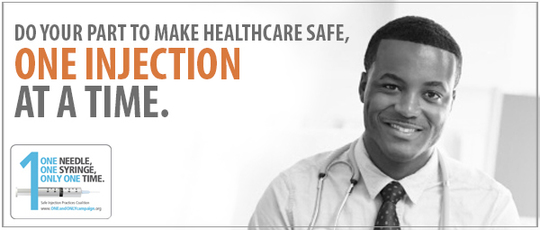
Calling all infection preventionists, directors of
nursing, and nurse educators! MDH is hosting a free, three-part Injection Safety
Workshop webinar series on March 6, 13 & 27, 2018. The Injection Safety
webinar series will give participants the tools to review injection safety
practices within their own facility and identify steps to create an injection
safety program. Participants must register for and attend all three sessions in
order to be eligible for CEUs.
- March 6, March 13, and March 27, 2018
Each session will be held 11:30 a.m.-12:30 p.m. central. (Note: there will be no webinar session on March 20.)
Learn more and register in advance to attend each webinar: Injection Safety Workshop Webinar Series
Contact the MDH HAI unit at
Health.HAI@state.mn.us with any questions.
The CDC’s
Division of Healthcare Quality Promotion (DHQP) published three national data
reports that use healthcare-associated infection (HAI) data reported to
National Healthcare Safety Network (NHSN) to help each state
understand its progress toward reducing HAIs. These reports comprise HAI
prevention progress and next steps in eliminating HAIs.
 |
Join the CDC and the American Nurses Association in the webinar: Empowering Nurses to Protect Themselves and Their Patients: Exploring Best Practices in Injection Safety.
Date: Thursday, February 22, 2018
Time: 12:00 noon
This webinar in the Empowering Nurses to Protect Themselves and Their Patients webinar series will focus on common issues related to safe injection practices. Nurses' role in adhering to injection safety best practices is critical to patient safety and health care personnel safety. This webinar will:
- Describe the essential balance between meeting immediate or emergent patient safety needs and performing all recommended infection control practices during clinical care.
- Identify safe injection practices intended to prevent catheter-related bloodstream infections.
- Describe a type of injection practice that might occur in a hemodialysis facility that would increase a patient's risk for infection.
Register and view the detailed agenda: Empowering Nurses to Protect Themselves and Their Patients: Exploring Best Practices in Injection Safety
 The Minnesota Department of Health has invited high school students to participate in the Lights, Camera, Action for Antibiotics Video Contest. Six finalists were selected and are awaiting your vote! Choose the video that you think will best spread the word about antibiotic resistance and responsible antibiotic use in health care.
Vote now! Voting closes at 4 p.m. today!: Lights, Camera, Action for Antibiotics Video Contest
|
The Society for Healthcare Epidemiology of America (SHEA)
recently published expert guidance regarding duration and
discontinuation of contact precautions in acute care facilities for a
number of multidrug resistant organisms (MDROs). Current guidelines are
incomplete due to limited data on the duration of colonization and the
effectiveness of contact precautions in reducing the spread of organisms such
as MRSA, VRE, CRE, and C. difficile. While there is no single
recommended approach, the authors recommend that facilities adopt specific
contact precautions policies, taking into account the available literature, the
epidemiology of the MDRO in their institution, their priorities, and available
resources.
Source: Banach,
D., Bearman, G., Barnden, M., Hanrahan, J., Leekha, S., Morgan, D.,...Wiemken, T. (2018). Duration
of Contact Precautions for Acute-Care Settings. Infection Control &
Hospital Epidemiology, 39(2), 127-144. doi:10.1017/ice.2017.245
At this time of year, hospitals reporting to the National
Healthcare Safety Network (NHSN) complete the Annual Hospital Survey, assessing
facility and infection prevention program characteristics. In 2014, the CDC
added questions about the hospital’s antibiotic stewardship program (ASP). The
CDC and The Joint Commission endorse the following Core
Elements of Hospital ASP: Leadership, Accountability, Drug Expertise,
Action, Tracking, Reporting, and Education. The NHSN survey assesses the adoption
of each ASP Core Element. Here are some of the results, with a focus on
Minnesota hospitals.
The
key metric used by CDC to judge ASP progress, over time and among states, is
the proportion of hospitals reporting adoption of all seven ASP Core
Elements. Minnesota’s result of 41% for
2016 (51/124) was in the lowest one-quarter of performance among states (Figure
1). This map shows the proportion of all acute care hospitals in each
state that report adoption of all seven AS Core Elements. Nationally, 64% of
all hospitals reported adoption of all Core Elements.
Figure 1. Percentage of Facilities in Each State
Meeting all 7 Core Elements, 2016 (CDC)
A closer look at Minnesota data also shows:
- Performance of Minnesota hospitals on this measure has improved over past years. In 2014, 22%, and in 2015, 24% of hospitals reported adopting all seven Core Elements.
- Consistent with national results, Minnesota Critical Access Hospitals (CAHs) scored lower on this measure in comparison with other acute care hospitals. In 2016, 34% of Minnesota CAHs reported adoption of all Core Elements, compared with 54% of other acute care hospitals. Nationally, 43% of CAHs and 70% of other acute care hospitals reported this result. Therefore, although Minnesota has a higher proportion of CAHs reporting to NHSN than most other states, this difference does not completely account for Minnesota’s lower performance on this measure.
- According to 2016 surveys, the Core Element most frequently adopted was Action, meaning use of one or more specific interventions to influence prescribing. Ninety-four percent of Minnesota hospitals reported adopting Action, and 97% of hospitals nationally. Among the six other Core Elements, fewer Minnesota hospitals reported adopting Leadership (69%) and Education (71%).
- In Minnesota, the interventions reported more frequently were: treatment recommendations (77%), prescribing review with feedback to providers (71%), and a pre-approval requirement for some antibiotics (56%). Less frequently reported included: having a policy requiring that the indication for antibiotics be documented in medical records (42%), and antibiotic time-out, which requires a reassessment of antibiotic appropriateness at about 48 hours after the first dose (26%).
The Joint Commission incorporated the CDC’s seven ASP Core Elements into its 2017 Antimicrobial Stewardship Standard. This certification requirement may help Minnesota hospital stewardship staff make the case to continue to strengthen their hospital ASPs.
More about the Annual Hospital Survey:
- CDC recommends that respondents consult with
staff responsible for the hospital ASP to ensure accurate answers to the ASP
questions.
-
The
NHSN deadline for completing the 2017 survey is March 1, 2018, but as elements
from this survey are used in risk adjustment models, CDC recommends completion
by February 15.
Dentists prescribe approximately 10% of the antibiotics
in outpatient settings in the US, which amount to over 24 million
prescriptions in 2013. Antibiotics are not harmless drugs—Clostridium
difficile infection (C. diff) is a potential complication of
antibiotic use and can occur after even one dose of an antibiotic.
MDH conducts sentinel C. diff surveillance in five
Minnesota counties and is the only health department in the country that
routinely interviews C. diff cases about their illnesses. Through these
interviews, MDH found that 15% of community-associated C. diff cases who
took antibiotics were prescribed antibiotics for a dental procedure. In
dentistry, antibiotics are primarily given to treat oral infections or to
prevent infections in high-risk patients who are having invasive dental
procedures. However, some dentists prescribe, or are pressured by other medical
providers to prescribe, antibiotics prophylactically before a dental procedure
to prevent a heart infection in patients with heart conditions, or to prevent
an infection of an artificial joint, such as a hip or knee replacement. The ADA
no longer recommends preventive antibiotics in most of those cases. Dentists
have often been overlooked as major partners in programs that promote
appropriate antibiotic use. It is critical that dentists are included in
efforts to improve antibiotic prescribing. All prescribers, including dentists,
should examine prescribing behaviors and incorporate available guidelines into
daily clinic practice. MDH also found that one-third of the patients' medical
records made no mention of antibiotics prescribed for dental reasons. This
underlines the need to improve communication between the dental and medical
communities.
Read
more about the research here:
CIDRAP:
Study links dental antibiotics to C diff cases
The Minnesota Antibiotic
Stewardship Conference, hosted by the Minnesota Department of Health, Minnesota Hospital Association, and Stratis Health, will be on May 1, 2018. There is no cost to attend this full-day conference!
This year, the
conference will focus on ambulatory care settings. Content will be relevant to
primary care clinics, emergency and urgent care departments, dental clinics,
and other care settings where outpatient antibiotics are prescribed.
Stay tuned for 2018 registration details: Stratis Health: Health Care Providers
Last
year's conference focus was long-term care, and materials can still be accessed
here: 2017 MN Antibiotic Stewardship Conference
|